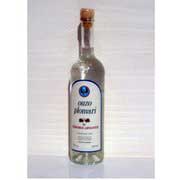- Ouzo Barbayanni: Production
- Ouzo from GreekNet.com
- Ouzo from GreekProducts.com
.

A bottle of ouzo
Ouzo (ούζο) is a Greek anise-flavored liqueur that is widely consumed in Greece. The name is of uncertain origin, but dates back to the late 19th century. It is similar to absinthe, but without the wormwood.
The history of ouzo is somewhat murky, but some claim it may date back in one form or another to ancient times. Its precursor is raki, a drink distilled throughout the Byzantine and later Ottoman Empires, often in those days of quality approaching moonshine (similar liquors in Turkey and many Arab countries still go by that name).
Modern ouzo distillation largely took off in the 19th century following Greek independence, with much production centered on the island of Lesvos, which claims to be the originator of the drink and remains a major producer. In 1932, ouzo producers developed the method of distillation using copper stills, which is now considered the canonically proper method of production. One of the largest producers of ouzo today is Barbayiannis (Βαρβαγιάννης), located in the town of Plomari in the southeast portion of the island.
Ouzo starts as a strong spirit made from pressed grapes or raisins. Other herbs and berries may also be added at the fermentation stage. The distinctive smell of ouzo comes from the addition of anise (or star anise) as a flavouring, but other ingredients, varying according to the producer, are also used; common ingredients include coriander, cloves, angelica root, liquorice, mint, wintergreen, fennel, hazelnut, cinnamon and lime blossom. The alcohol and flavourings are placed in warmed copper stills and distilled; higher-quality ouzos may be distilled several times. The resulting spirit is then cooled, stored for a few months, and then diluted, usually to around 40% ABV.
In modern Greece, ouzeri can be found in nearly all cities, towns, and villages. These cafe-like establishments serve ouzo with mezedes -- appetizers such as octopus, salad, sardines, calamari, fried zucchini, and clams, among others. It is traditionally slowly sipped (usually mixed with water or ice) together with mezedes shared with others over a period of several hours in the early evening. When water or ice is added to ouzo it turns milky white; this is because the etheric oils are soluble in alcohol but not water. Diluting the spirit to less than around 40% ABV causes it to separate into an aqueous and an organic phase, whose fine droplets scatter the light.
The crystals sometimes seen in ouzo served cold are crystalline anethole, the constituent of anise aroma.
In many areas, individuals or small-time local producers make tsipouro, which is essentially a home-made small-batch variant of ouzo. The taste of tsipouro varies widely by producer, but many Greeks prefer their favorite local tsipouro to the more commonly-available brands of mass-produced ouzo. The traditional hospitality greeting for travellers visiting the monasteries at Mount Athos is a small glass of tsipouro and a loukoumi, a candy-like homemade treat.
Church of Ouzo Founded in 1984 and named after the great star called Wormwood that fell from heaven and poisoned the waters in the book of Revelation 8:10-11. Ouzo is similar to absinthe, but without the wormwood.
Links
See also
| Ancient Greece
Science, Technology , Medicine , Warfare, , Biographies , Life , Cities/Places/Maps , Arts , Literature , Philosophy ,Olympics, Mythology , History , Images Medieval Greece / Byzantine Empire Science, Technology, Arts, , Warfare , Literature, Biographies, Icons, History Modern Greece Cities, Islands, Regions, Fauna/Flora ,Biographies , History , Warfare, Science/Technology, Literature, Music , Arts , Film/Actors , Sport , Fashion --- |
Retrieved from "http://en.wikipedia.org/"
All text is available under the terms of the GNU Free Documentation License

